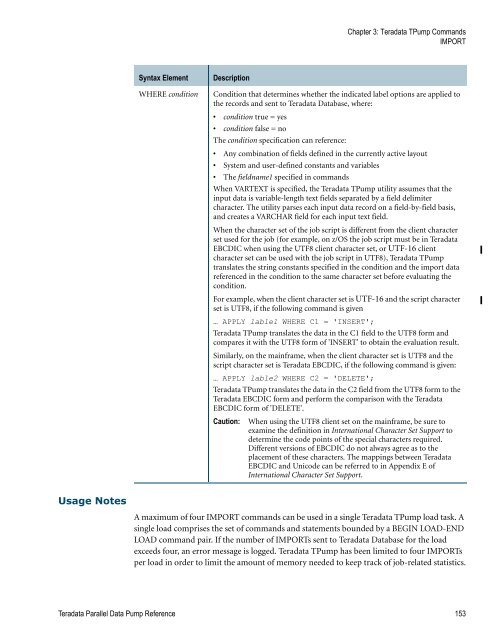Teradata Parallel Data Pump
Teradata Parallel Data Pump Reference - Teradata Developer ...
Teradata Parallel Data Pump Reference - Teradata Developer ...
- No tags were found...
Create successful ePaper yourself
Turn your PDF publications into a flip-book with our unique Google optimized e-Paper software.
Chapter 3: <strong>Teradata</strong> T<strong>Pump</strong> Commands<br />
IMPORT<br />
Syntax Element<br />
WHERE condition<br />
Description<br />
Condition that determines whether the indicated label options are applied to<br />
the records and sent to <strong>Teradata</strong> <strong>Data</strong>base, where:<br />
• condition true = yes<br />
• condition false = no<br />
The condition specification can reference:<br />
• Any combination of fields defined in the currently active layout<br />
• System and user-defined constants and variables<br />
• The fieldname1 specified in commands<br />
When VARTEXT is specified, the <strong>Teradata</strong> T<strong>Pump</strong> utility assumes that the<br />
input data is variable-length text fields separated by a field delimiter<br />
character. The utility parses each input data record on a field-by-field basis,<br />
and creates a VARCHAR field for each input text field.<br />
When the character set of the job script is different from the client character<br />
set used for the job (for example, on z/OS the job script must be in <strong>Teradata</strong><br />
EBCDIC when using the UTF8 client character set, or UTF-16 client<br />
character set can be used with the job script in UTF8), <strong>Teradata</strong> T<strong>Pump</strong><br />
translates the string constants specified in the condition and the import data<br />
referenced in the condition to the same character set before evaluating the<br />
condition.<br />
For example, when the client character set is UTF-16 and the script character<br />
set is UTF8, if the following command is given<br />
… APPLY lable1 WHERE C1 = 'INSERT';<br />
<strong>Teradata</strong> T<strong>Pump</strong> translates the data in the C1 field to the UTF8 form and<br />
compares it with the UTF8 form of 'INSERT' to obtain the evaluation result.<br />
Similarly, on the mainframe, when the client character set is UTF8 and the<br />
script character set is <strong>Teradata</strong> EBCDIC, if the following command is given:<br />
… APPLY lable2 WHERE C2 = 'DELETE';<br />
<strong>Teradata</strong> T<strong>Pump</strong> translates the data in the C2 field from the UTF8 form to the<br />
<strong>Teradata</strong> EBCDIC form and perform the comparison with the <strong>Teradata</strong><br />
EBCDIC form of 'DELETE'.<br />
Caution:<br />
When using the UTF8 client set on the mainframe, be sure to<br />
examine the definition in International Character Set Support to<br />
determine the code points of the special characters required.<br />
Different versions of EBCDIC do not always agree as to the<br />
placement of these characters. The mappings between <strong>Teradata</strong><br />
EBCDIC and Unicode can be referred to in Appendix E of<br />
International Character Set Support.<br />
Usage Notes<br />
A maximum of four IMPORT commands can be used in a single <strong>Teradata</strong> T<strong>Pump</strong> load task. A<br />
single load comprises the set of commands and statements bounded by a BEGIN LOAD-END<br />
LOAD command pair. If the number of IMPORTs sent to <strong>Teradata</strong> <strong>Data</strong>base for the load<br />
exceeds four, an error message is logged. <strong>Teradata</strong> T<strong>Pump</strong> has been limited to four IMPORTs<br />
per load in order to limit the amount of memory needed to keep track of job-related statistics.<br />
<strong>Teradata</strong> <strong>Parallel</strong> <strong>Data</strong> <strong>Pump</strong> Reference 153









